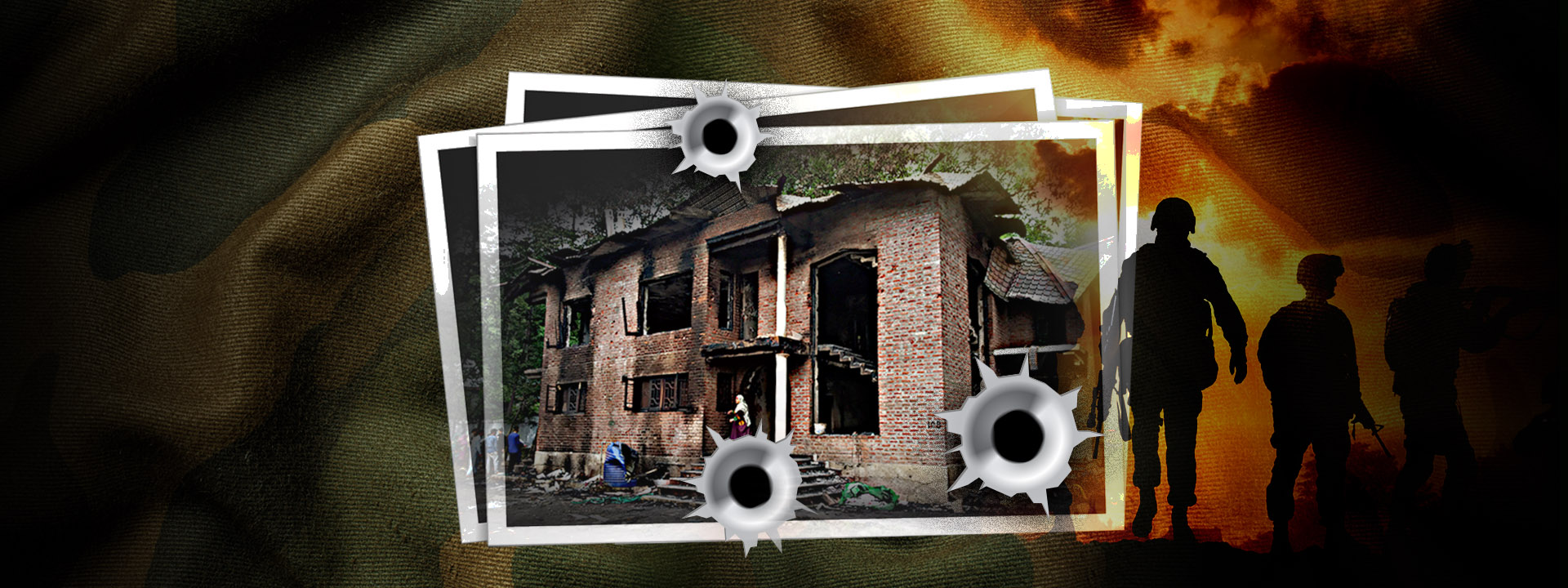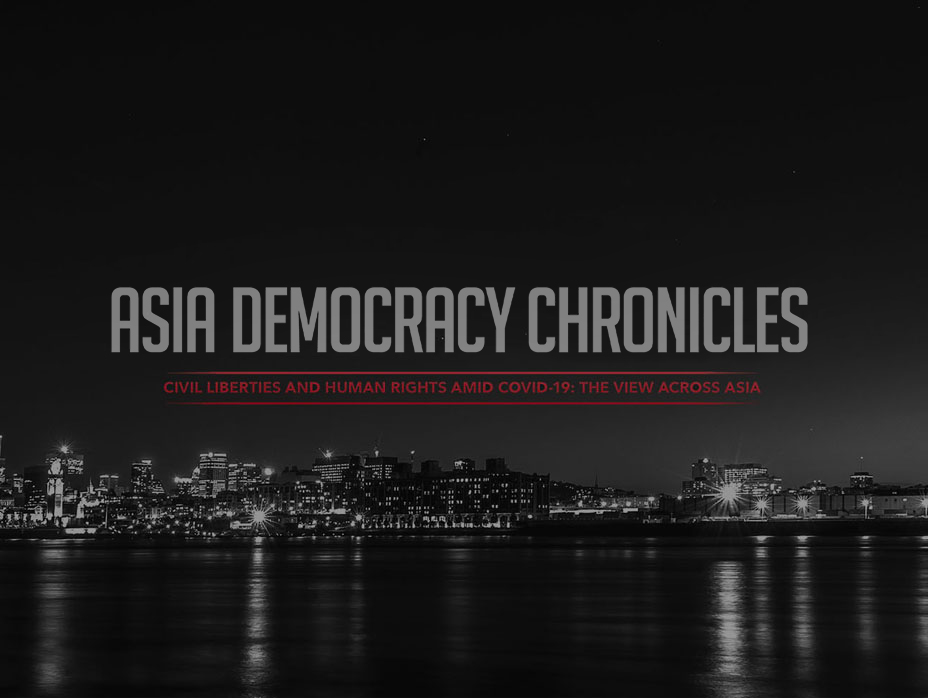Abroken geyser, dented kitchen sink, wreckage of washing machine, utensils, and toys are under the debris of what used to be a kitchen and washroom. The burnt wooden windows and doors still emanate the smell of smoke. One whole side of the house has been left standing, but it looks like a skeleton.
The remains of this single-story home are in Rajpora, a small village surrounded with apple orchards in Pulwama district of Indian-administered Kashmir. The house — or what’s left of it — belongs to Shabir Ahmad Dar, 38, a chef by profession. On the evening of 2 July, Dar and his colleagues were preparing a wedding feast in a neighboring village when he received a frantic call from his 34-year-old wife Zahida Akhter.
“’Some militants have taken shelter in our house and the army personnel have cordoned off the whole area,” Dar recalls his wife as telling him. “’Encounter will break out anytime.’”
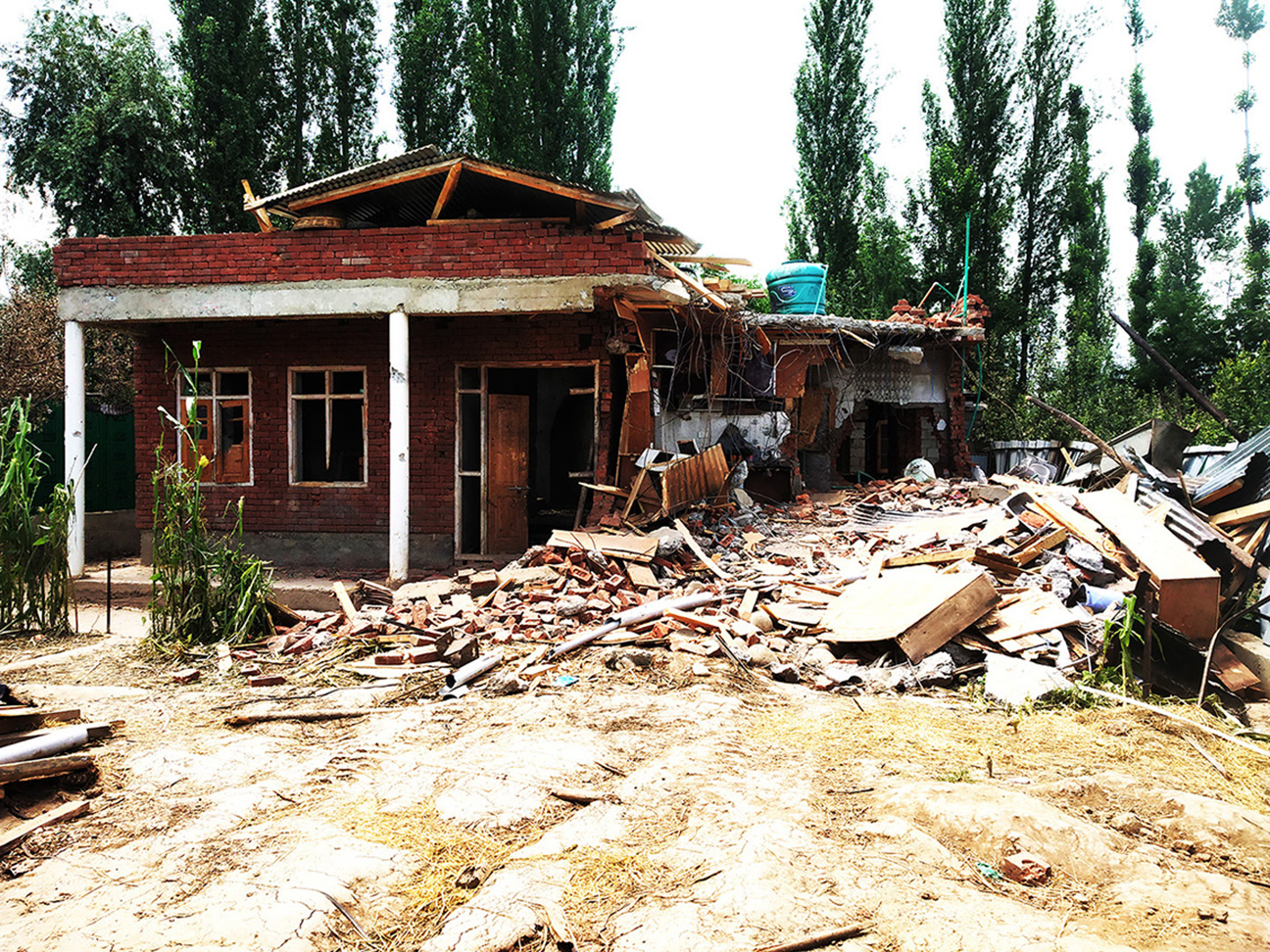
This is what’s left of Shabir Ahmad Dar’s dream home just two years after he completed building it. Military forces took over the house and it was eventually destroyed in a bombing operation. (Photo by Aamir Ali Bhat)
Dar’s wife had just given birth a little more than a fortnight ago. Her call had Dar hurriedly leaving work and running toward home. But he was stopped on the way by Indian paramilitary forces. In the meantime, his house was being bombed by Indian armed forces. The gunfight eventually left five armed rebels and one soldier dead.
Before the gun battle started, Dar’s family, including his wife and three children, had been taken out of the house. “Military forces sent a civilian who took us out,” Akhter says, cradling her newborn baby. “We were just a few meters away from our house when the firing started.”
Dar and Akhter had saved up for years to build the house, which was finally completed two years ago. Now it is mostly rubble; Dar and his wife and children are now staying with his brother’s family, just 200 meters away from what used to be their home.
Their experience is not unique. Tens of thousands of families have lost their houses and others structures during the last three decades of conflict, violence, and destruction in the disputed Himalayan region of Indian-administered Kashmir. Videos and photographs of some gun battles that went viral on social media have exposed how Indian armed forces blasted civilians houses during encounters with armed rebels.
Death and destruction
Kashmir is wedged between two arch-rival neighboring countries, India and Pakistan. Both claim the region in its entirety, but each controls only parts of it. In the late 1980s, armed insurgency broke out in the part of Kashmir controlled by India. Several rebel groups who are fighting Indian paramilitary forces want either a separate nation or a merger of the territory with Pakistan. But counter-insurgency practices employed by Indian paramilitary forces to crush the rebellion have often left a trail of destruction.
There are no official data on destroyed civilian properties, but some recent reports by local human-rights groups reveal the magnitude of destruction people in Kashmir have witnessed during the last couple of years. For example, the reports reveal that in the first half of July alone, at least 22 armed rebels were killed in nine encounters, while scores of families were left homeless.
According to the local human-rights group Jammu and Kashmir Coalition of Civil Society (JKCCS), during the first half of 2020, 48 pieces of property were destroyed in 57 encounters between Indian armed forces and armed rebels. In 2019 hundreds of families were left homeless in 89 encounters, while in 2018 — the deadliest year in a decade in Kashmir — JKCCS data reveal that 125 houses were either partially or fully destroyed in Kashmir.
The anti-insurgency operations have continued unabated in Kashmir despite the UN Secretary-General Antonio Guterres’s call in March 2020 for a global ceasefire in conflict regions amid the outbreak of COVID-19. The urgent call was endorsed by 180 countries, the UN Security Council, regional organizations, civil-society groups, peace advocates, and millions of global citizens.
India — which enforced lockdowns during the first and second wave of the COVID-19 pandemic and asked citizens to stay indoors to stem the spread of COVID-19 — ignored the call. And the non-stop encounters by Indian paramilitary forces in Kashmir have kept on leaving hundreds of families without any shelter to call their own.
“When the government was enforcing stay-at-home order throughout India, we were left homeless,” says Tahiri Jan, whose house became a casualty in the conflict. “The worst part was we weren’t provided with any help by the administration. People were battling the pandemic and we were battling homelessness amid the pandemic.”
No compensation forthcoming
The continuous destruction of civilian properties is in gross violation of international laws like Article 53 of the Fourth Geneva Convention, which states, “Any destruction by the dominant military power of real or personal property belonging individually or collectively to private persons is prohibited, except where such destruction is rendered absolutely necessary by military operations.”
Yet families who had their properties destroyed can’t even file a case against Indian soldiers because the Armed Forces Special Powers Act (AFSPA) gives the latter legal cover from persecution. Imposed in Kashmir in 1990, the draconian law allows military forces to shoot to kill, arrest on flimsy pretext, conduct warrantless searches, and demolish structures in the name of “aiding civil power.”
In the area that is declared to be “disturbed,” Section 4(b) of the Act allows armed forces to “destroy any arms dump, hide-outs, prepared or fortified position or shelter or training camp from which armed attacks are made by the armed volunteers or armed gangs or absconders wanted for any offense.”
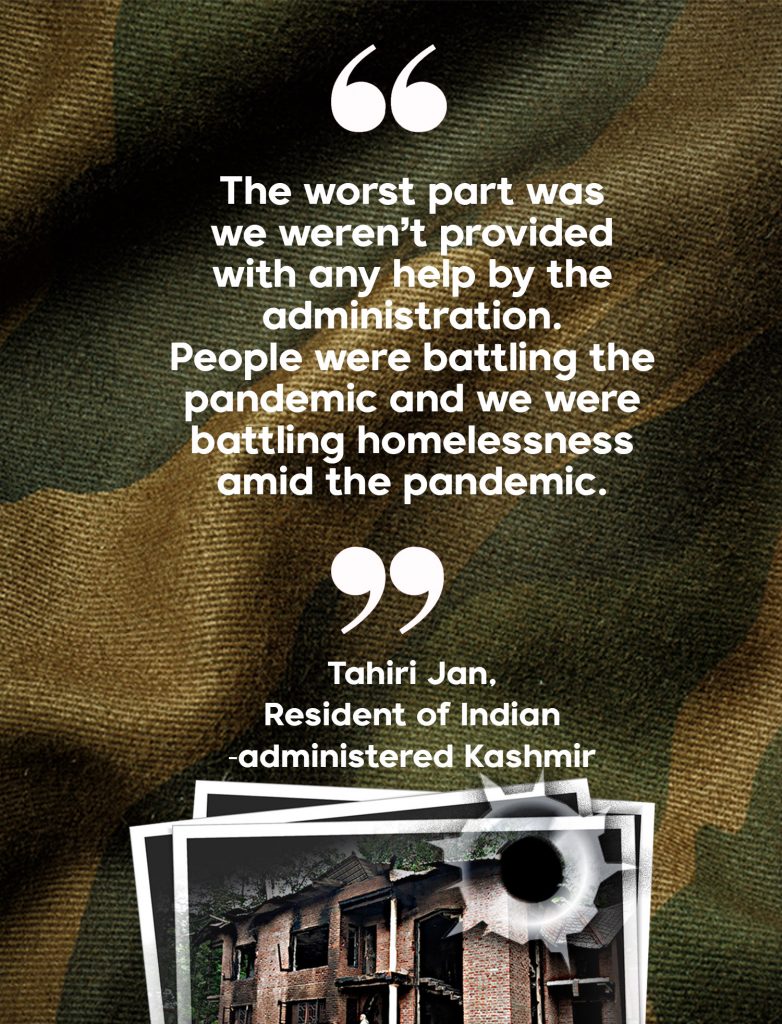 Unless the central government grants prior permission to prosecute, Section 7 of the AFSPA prohibits the prosecution of security forces personnel. According to a UN report published in 2018, in three decades that the law has been in force in Jammu and Kashmir, there has not been a single prosecution of armed forces personnel granted by the central government.
Unless the central government grants prior permission to prosecute, Section 7 of the AFSPA prohibits the prosecution of security forces personnel. According to a UN report published in 2018, in three decades that the law has been in force in Jammu and Kashmir, there has not been a single prosecution of armed forces personnel granted by the central government.
In 2019, in its first ever report on human rights violations on Kashmir, the United Nations said that the Cordon and Search Operations (CASO) — an anti-insurgency exercise conducted by Indian soldiers on specific inputs about the presence of armed rebels — enable a range of human-rights violations including physical intimidation and assault, invasion of privacy, arbitrary and unlawful detention, collective punishment and destruction of private property. The report further noted that homeowners have yet to receive any compensation from Indian authorities.
In most cases, those who lost their homes are denied compensation because they have been accused of willingly giving shelter to armed rebels. The bedridden Akhter, however, remarks: “We are living under the shadow of a gun. A group of militants who were chased by soldiers entered our house and in a short time our lifelong savings that we had spent to build a new house were destroyed.”
Akhter says that going by previous cases, they are not hoping to get anything from Indian authorities.
Asia Democracy Chronicle (ADC) repeatedly called Kashmir Police Inspector General Vijay Kumar, but he didn’t pick up. A questionnaire sent to him via email remains unanswered. But according to a government official who asks to remain anonymous because he is not authorized to talk to the media, there is a policy to compensate those who lost their property during gun battles.
“Those who willingly support and give shelter to militants don’t receive any compensation from the government,” concedes the official. But he clarifies, “If a victim makes claim, the administration directs police to probe whether the family was involved in abetting militants.”
Generally, however, families left homeless in the conflict stay away from making any complaint, with most saying that the process is tiring and the money given is meager in comparison to what has been lost.
Help from neighbors and relatives
Some 18 kms from Akhter’s hometown, in Rawalpora area of South Kashmir’s Shopian district, Shameem Ahmad Lone and his wife Shabnum are working on rebuilding their home. Just last March, their home and five other houses and two cowsheds were razed by Indian armed forces during a three-day encounter in which two armed rebels were killed. Pointing toward the right side of her under-construction house, Shabnum says, “Here was our kitchen. A day before the encounter started I was cooking there and had never thought a storm was afoot that would change our life.”
It was, Lone says, a typical Kashmiri kitchen. He also recalls wistfully how the house also had shelves that displayed a stunning array of knickknacks and walls painted in joyful colors. All that was reduced to rubble in the blink of an eye, he says. Lone and his wife and three children are now staying with relatives, the family of five all in one compact room. Standing next to his wife near their home’s construction site, Lone says, “Except the clothes we had on at the time of encounter, everything else was destroyed.”
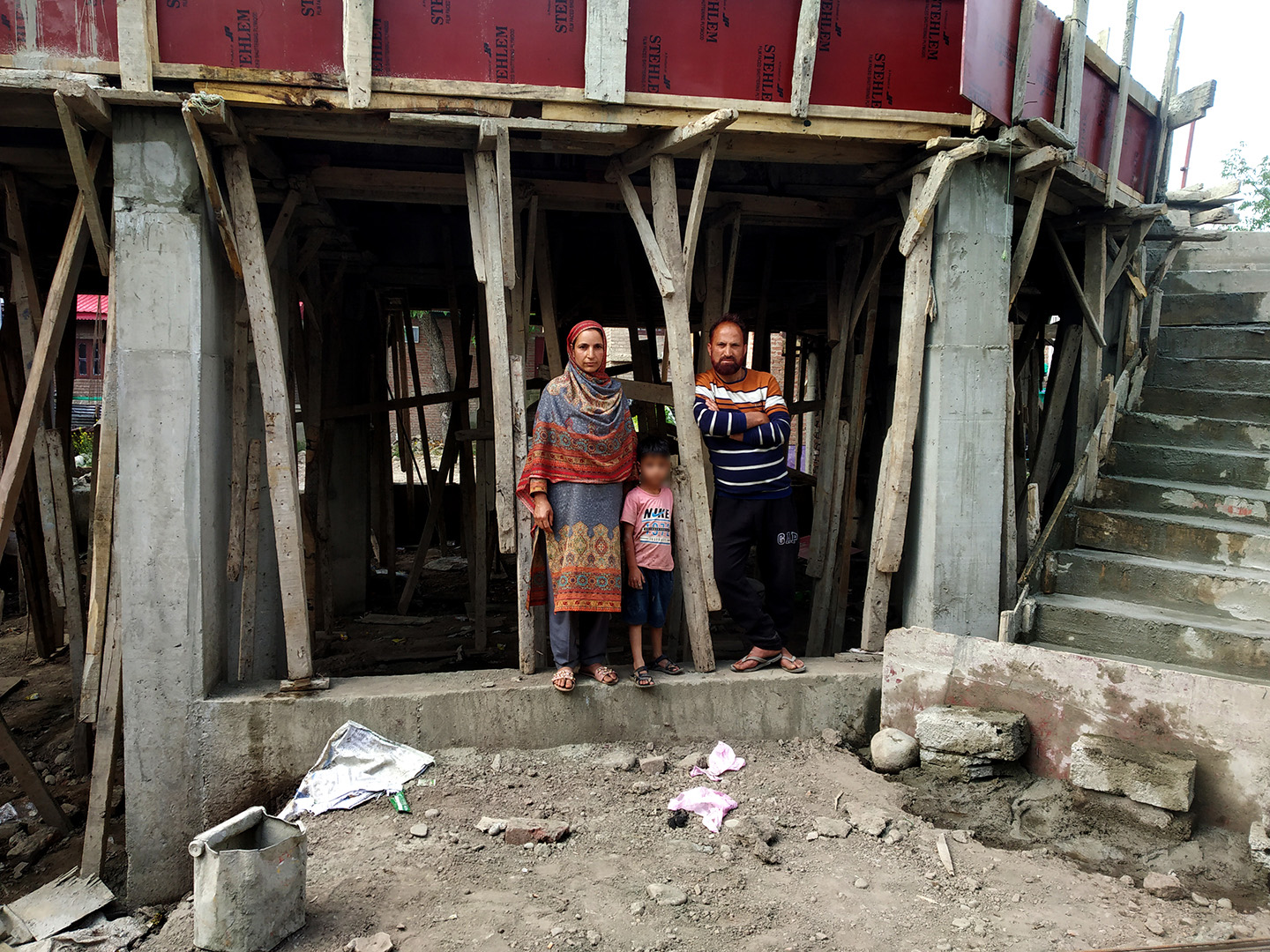
Shameem Ahmad Lone, here with his wife Shabnum and their child, are still reeling from the effects of the conflict but have decided to rebuild. (Photo by Aamir Ali Bhat)
The 45-year-old Lone hasn’t received any compensation from the government. “Nobody, from officials or whoever, even visited here,” he says. “We were left to die. It takes lifetime savings and years of hard work to build a house in Kashmir.”
But locals have been stepping up to support families who need to rebuild their homes. In the aftermath of every gunfight, hordes of people throng the encounter sites to show sympathy with homeowners left with only debris. Inevitably, a campaign to raise money to help the homeowners rebuild their property follows.
This was exactly what happened after at least 19 houses were destroyed in a 12-hour gunfight in May last year, leaving 21 families homeless in Srinagar, the capital city of Kashmir. (The encounter left two armed rebels dead while one policeman was injured.)
Following the gunfight, photos and videos posted on social media showing dark plumes of smoke billowing high above the locality went viral, and people vowed to help the suddenly homeless families. In seven days, INR 30 million (more than US$400,000) had been collected and distributed among the affected families.
“Because of overwhelming monetary support by locals we rebuilt our houses again,” says Tahira Jan, who stayed with her sister-in-law for about a year while her family home was being reconstructed. “People showed sympathy toward us and stood shoulder to shoulder with us until our life returned to normal. ●
Aamir Ali Bhat is a Kashmir-based independent journalist.










